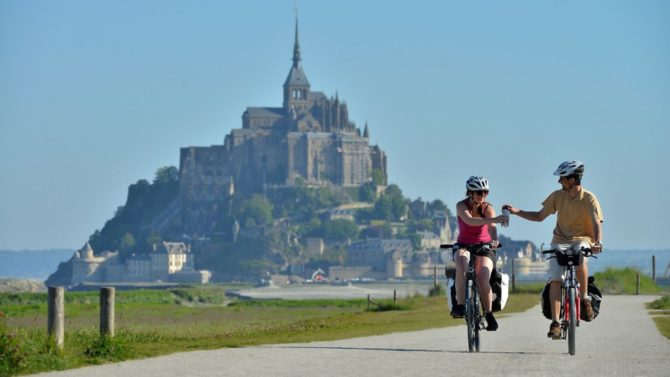Vive la véloroute! Buy a French property close to a family-friendly cycle path


Having a flat and traffic-free cycle path close to your French home is sure to boost its appeal to you and your guests, says Ruth Wood

It’s amazing how your househunting choices in France multiply if you’re willing to get on yer bike. Thanks to the country’s wealth of quiet and well-surfaced country lanes, people too anxious to cycle on busy British roads can pedal for miles in relative relaxation.
And then there are the voies vertes, designated ‘greenways’ where motorised traffic is banned. Often hugging canals, rivers and old railway lines, these cycle paths are usually flat and easily accessible for all the family, making them a wonderful feature of holidays and an attractive selling point if you plan to rent out your property.
Vive les véloroutes
You can see the cycle path network at a glance on the website af3v.org, the national association for the development of véloroutes (cycle routes which may include quiet roads) and voies vertes (greenways that are guaranteed traffic-free). On its interactive map (carte), the purple lines show greenways with smooth surfaces that are accessible not only to cyclists but to wheelchair-users and rollerskaters. The pink lines show greenways with slightly rougher surfaces, though some are still wheelchair-accessible. The orange lines show cycle routes that make some use of quiet roads. The dotted lines show routes that are well used but don’t quite meet the strict criteria laid down by the association, and the grey lines show routes that are mid-construction or proposed.
Most, but not all, of these greenways also show up on Google Maps. Simply zoom in to an area of interest, then click on the Menu bars in the top left-hand corner and scroll down to ‘bicycling’, to see the routes marked in green.
Brittany and Burgundy are particularly well connected, as is the Atlantic seaboard and the countryside between Bordeaux and Toulouse along the Canal de Garonne and the Canal du Midi. Here are some of the traffic-free cycle paths in areas popular with British househunters.
Normandy: La Véloscénie
Starting in Paris, the Veloscenic (la Véloscénie) is the latest major cycle route to be opened in France. It’s a 450km journey across eight departments, through three regional parks and past five UNESCO World Heritage Sites, starting at Notre Dame cathedral and taking in the Eiffel Tower, Palace of Versailles and Chartres cathedral before ending at the world-famous Mont-St-Michel on the coast.

It’s not until the second half of the route, however, in Normandy, that you come to major sections of greenway. These are between Condé-sur-Huisne and Alençon in the Perche regional park and between Domfront in the Normandie-Maine regional park and Mont-St-Michel, with just a few short sections of road. If you do this last 80km section, there’s a steep road descent out of Domfront, but you will soon be on the greenway beside the River Sélune, enjoying the famous Normandy bocage (hedgerows). Look out for the Cance waterfalls outside the town of St-Hilaire-de-Harcouët and the flower-bedecked village of Ducey.
Don’t miss: 8 things to do in northern France like a local
Charente: La Coulée d’Oc
Open to everyone from joggers and rollerskaters to wheelchair-users and horse riders, the 21km-long Coulée d’Oc is a smooth, flat and linear greenway following the Bandiat valley along the old Angoulême-Nontron railway line. Most people start at Le Quéroy, about 10km from the Charente capital Angoulême and travel east to the picturesque village of Souffrignac on the Dordogne border. On the way, they pass through pretty villages and a lush pastoral and forested landscape, shielded from the sun by oaks and maples.
There are entry points at villages along the way, including Chazelles, St-Germain-de-Montbron, Marthon and Feuillade, and plans are afoot to link the path to Angoulême.
Don’t miss: Couple in their 20s swap Cornwall for Charente
Languedoc: The Passa Païs
Enjoy the mountains but cycle on the flat; that’s the joy of this 80km mostly flat greenway through the Haut-Languedoc regional park. Following an old railway line for most of the way, the Passa Païs links the Tarn town of Mazamet in the west to the Hérault town of Bédarieux in the east. It crosses the Atlantic-Mediterranean watershed that inspires its Occitan name (meaning ‘pass country’) and loosely traces the valley villages and hamlets of the Thoré, Jaur and Orb. Among these are the Belle Epoque spa town of Lamalou-les-Bains and the hilltop village of Olargues, one of the most beautiful villages in France.
Look out for the gorges of Colombières (above Colombières-sur-Orb) and Héric, the latter being a five-minute detour uphill at Mons to a series of mini waterfalls and crystal clear pools.

Bear in mind, the Passa Païs route is compacted sand, so it is not really suitable for road bikes, though it is wheelchair-friendly and ideal for children. There are also a few steep stretches, including a short section west of Olargues where the route leaves the railway line.
Don’t miss: An insider’s guide to Hérault
Burgundy: La grand boucle de Bourgogne-du-Sud
It was in beautiful bike-friendly southern Burgundy that the first ever voie verte (greenway) was created, between Givry and Cluny. Today that stretch is part of a 145km circuit called the Bourgogne du Sud loop, which links Chalon-sur-Saône and Mâcon, and is usually done in three or four days. On the west side, the greenway tracks the pretty Grosne valley and a disused railway line at the foot of the Côte Chalonnaise vineyards. After Cluny, it climbs to the Tunnel du Bois Clair, the longest tunnel in Europe open to cyclists (closed in winter).
It then emerges into a landscape of limestone cliffs and steep vineyards sloping down to the River Saône and the town of Mâcon. On the east side, the route follows the Saône to Tournus where the abbey is celebrating its 1,000th anniversary this year. Only the last 32km up to Châlon is for experienced cyclists. It traces a provisional stretch of cycle route along minor roads, which are due to be turned into an official part of the circuit in due course. From Châlon, you can continue north along the Canal du Centre greenway to Chagny and beyond.
Don’t miss: How to spend a weekend in Dijon, France’s mustard capital
Lot-et-Garonne: Le Canal des Deux Mers
Ultimately, it is hoped there will be a traffic-free cycle route connecting the Atlantic coast to the Mediterranean along the Canal de Garonne and Canal du Midi. Much of this véloroute, called Le Canal des Deux Mers, is already well developed, particularly south of Bordeaux to south of Toulouse and again around Béziers, but there is still some work to do to improve the surface in Aude around Carcassonne.
A particularly lovely section is the 41km of greenway north of Lot-et-Garonne capital Agen between Buzet-sur-Baïse and Meilhan-sur-Garonne, which is handy also for the Lot valley véloroute. From Buzet-sur-Baïse, the towpath is bordered by plane trees and passes through fields of corn and sunflowers past flower-bedecked canal locks and the occasional refreshment stop.
At Mas-d’Agenais, you can walk into the village to see a Rembrandt painting in the church and at Pont des Sables you can take a detour to the town of Marmande where there is a train station. At Gravières lock, it’s worth a detour into Couthures-sur-Garonne to visit the rural life museum.
Don’t miss: Gentle canalside cycling between two seas
Brittany: La Vélodyssée
An epic 1,200km route called La Vélodyssée connects Roscoff on the north coast of Finistère to Hendaye on the Spanish border, with 70% of it on traffic-free paths. It crosses through the heart of Brittany and follows the Atlantic coast through La Rochelle, a particularly good stretch being the 190km between the beautiful bay of Arcachon in Gironde and Bayonne in Pyrénées-Atlantiques, taking in Europe’s largest sand dune and the surfing beaches.
But an area more popular with British househunters is in central Brittany where the trail snakes through the Armorique regional park near Huelgoat and picks up the Blavet and Oust rivers (the Nantes-to-Brest canal) past the Abbaye de Bon Répos (famous for its summer lightshow), Lac de Guerlédan (a lake with beaches and watersports) and through medieval towns such as Josselin and Malestroit.
Don’t miss: The best places in central Brittany to buy a property
You may also like:
Loire à Vélo – An epic 800km cycle route through the Valley of the Kings and the Garden of France, from Nevers to the Atlantic, mostly on very quiet roads but with some greenway sections, around Blois, Amboise and Tours for example.
La Vallée du Lot – A meandering 163km cycle route through the Lot Valley past several perched villages, from Aiguillon or Tonnein to Cahors, with a few greenway sections.
La Véloroute du Calavon – A 37km unofficial greenway through the Luberon hills of Provence, following an old railway line along the Calavon valley, from Robion to St-Martin-de-Castillon.
Le Tour de Creuse – A circuit of over 400km of signposted cycle paths in Creuse, incorporating the popular Vassivière leisure lake and tapestry town of Aubusson
Don’t miss: Tips and tricks for cycling in France
Share to: Facebook Twitter LinkedIn Email


